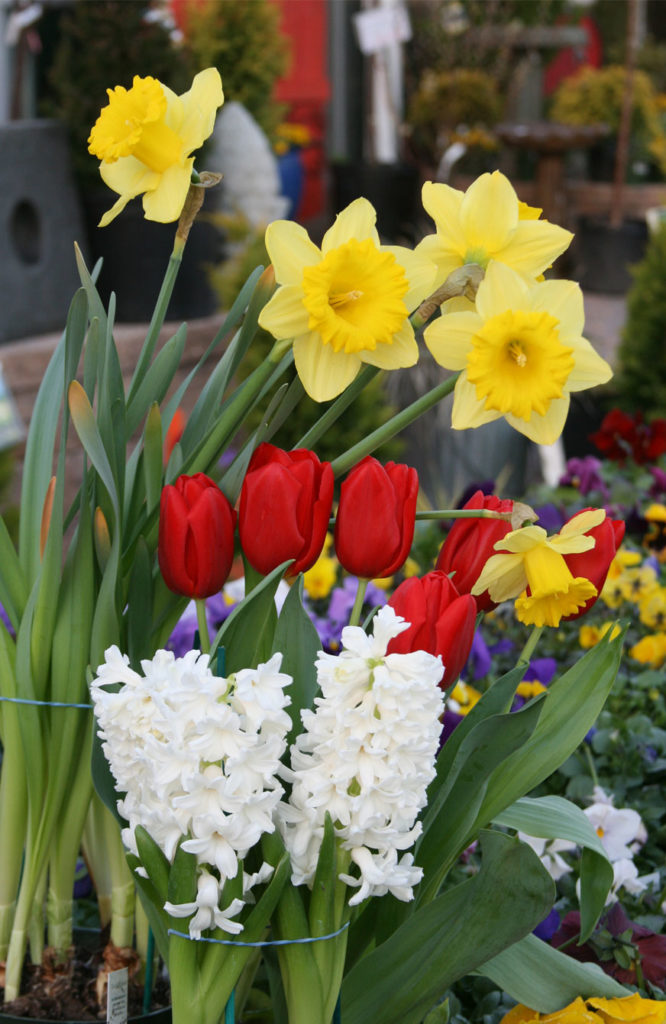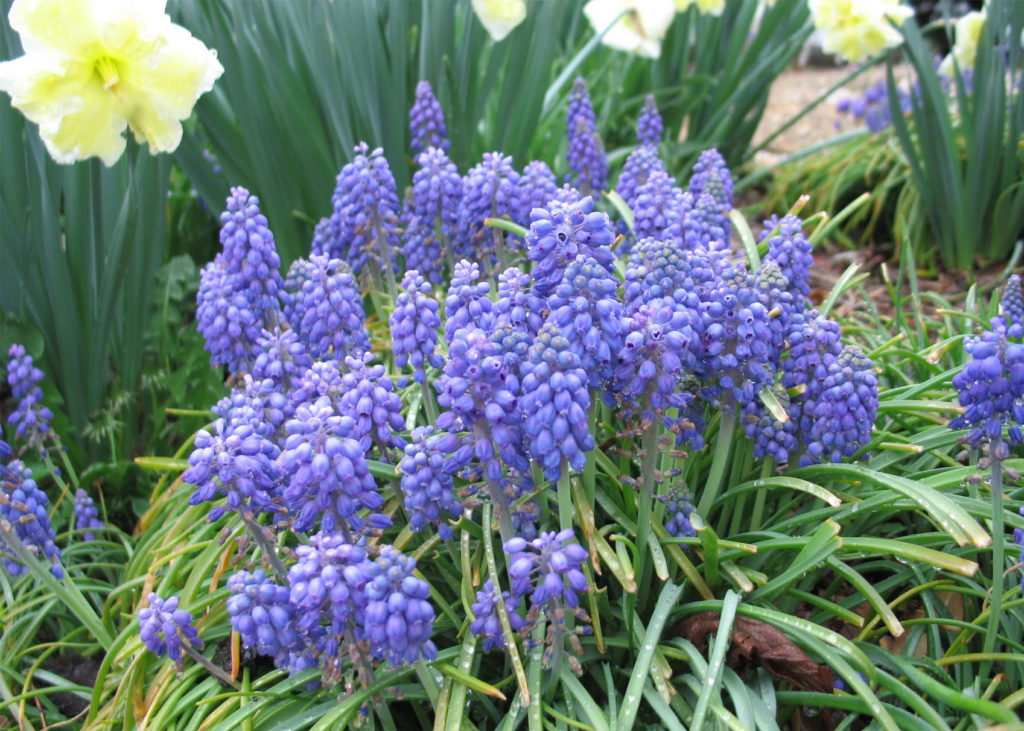Fall-Planted, Spring-Flowering, “Dutch Bulbs”
Planning and a leap of faith: that’s what it takes to be successful with bulb planting. Planning, because you need to plant them in advance of when you need them, and a leap of faith because you have to believe that this little chunk of stuff with no leaves is going to become a plant. And not just a plant, but a plant with spectacular flowers.
So 6 to 8 months before you are the envy of your neighbors with your drifts of daffodils or your collages of crocuses, you have to actually buy and plant your bags of bulbs. It really isn’t necessary to plan, although the results tend to be better when you do. Bulb plantings look nicest when they are en masse instead of in lines, with multiple plants of the same variety, and, of course, if they are complementing other spring blooming plants such as hellebores or phlox, then so much the better. This is most easily accomplished by sketching things out on paper or your tablet before you hit the store.
First: what is a bulb? It’s an underground stem that loses its above ground leaves and goes dormant for a period of time in order to survive either dry or cold weather, or both. There are variations—corms, tubers—that are botanically different but are handled the same in commerce, so we just lump them all together as “bulbs” at the garden center.
They are called Dutch bulbs because most of them that we sell in the United States are grown in nurseries in the Netherlands. The Dutch were a big-deal maritime trading power at one point, and they imported a lot of bulbs and cornered the market and got the industry rolling and never let go.
The origin of the majority of the wild ancestors of the common winter-hardy bulbs is in Europe and Asia, especially the Middle East, and Mediterranean countries such as Spain in Europe and Morocco in North Africa.
We visit a lot of garden centers all across the country, and we are proud to say that our selection of bulbs is top notch. Size matters: bigger bulbs yield more and bigger flowers; those are the types of bulbs we have here at Behnke’s. Big bulbs and a wide selection of them.
When do bulbs flower?
From late winter to late spring, the general timing is a function of the species and variety. A given plant flowers from a few days to a few weeks depending on temperature (the hotter the weather, the faster they go out of bloom; hot, windy and low humidity conditions age flowers fast). If you just LOVE narcissus (daffodils) you can have them in flower for months by planting early season bloomers, mid-season, and late-season. As the early season bloomers finish, the mid-season bloomers begin, and so on. The package will tell you when they bloom and how tall you should expect them to get.
Are they perennial?
It depends on the type of bulb and the climate. Some naturalize: that is, they make additional bulbs each year that eventually reach flowering size and spread. “Minor” bulbs such as grape hyacinths, smaller/species tulips, many daffodils, those horrible wild garlic and onion plants in your lawn…naturalize.
Others “perennialize”: they flower for a few years, usually with fewer and smaller flowers as the years pass; then stop blooming, and you just get some straggly leaves. Most tulips, hyacinths. Big display gardens that do beds of tulips discard them after the one season’s bloom.
If you are naturalizing, then the tradeoff is that you have to allow the foliage to die back naturally after the plant flowers. This is how new bulbs are formed. All of the good stuff from the leaves is transported to the bulb for storage for next year.
 When are they planted?
When are they planted?
Plant them in the fall. Bulb quality decreases as the bulbs sit around (they dry out), so it’s best to buy them early for best selection, and keep them in a cool, dry place until you plant. We recommend planting daffodils in the mid-Atlantic region from mid-September to mid-October, for example. We have planted tulips as late as January and still had blooms, but they were very short plants and small blooms. You cannot hold them for a year and plant next fall.
How do I plant these things?
The Dutch have coined a slogan to show how easy planting bulbs is: “Dig, Drop, Done.” Easy-peasy; just pretend you’re a squirrel.
Most bulbs do best in full sun—that is, at least six hours of direct sunlight. It has to be soil that drains well after rain or they will rot. The bottom of the hole should be at a depth that is three to four times the height of the bulb. If your tulip bulb is two inches tall, the bottom of the hole should be 6 to 8 inches down. Place some Bulb-tone brand fertilizer in the bottom of the hole, per instructions on the bag. Add a bit of soil so that the bulb isn’t sitting right on top of the fertilizer, then place the bulb in the hole and cover with soil.
It’s best to plant the bulb with the pointy end up and the bulb plate at the bottom: this is the flat part of the bulb from which the roots emerge, like the bottom of an onion bulb.
If you want to save time, instead of digging a lot of little holes, dig wider holes and put more than one bulb in the hole.
Sorry Teacher, the dog ate my homework. What’s eating my bulbs?
Voles, which look like mice with short tails, tunnel through the soil and eat bulbs. Mix sharp gravel into the soil in your bulb plantings to hurt their little soft noses; the vole blood is a great bulb fertilizer, too.
Squirrels eat the bulbs; repellents seem pretty useless. Use poisonous bulbs like daffodils, which they will leave alone, or at least not eat. They may still dig them up for sport. For fine textured, small flowered bulbs like crocus, you might lay a wide-holed chicken wire on top of the soil after planting, and cover it with mulch to discourage digging.
Deer eat the flowers and may yank the bulbs up; repellents may help some, but the best bet is to use resistant bulbs; e.g., poisonous bulbs like daffodils. Avoid tulips.
So, that’s it. Shopping for bulbs is a lot of fun, and planting is pretty simple. The hardest part is waiting for next spring’s blooms.
by Larry Hurley, Behnke horticulturist




This Post Has 0 Comments